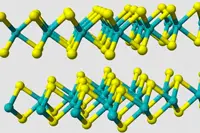 The interest in two dimensional materials continues to grow as researchers look to explore potential replacements for silicon in electronic devices.
The interest in two dimensional materials continues to grow as researchers look to explore potential replacements for silicon in electronic devices.
In the latest development, researchers at the University of Pennsylvania have have found a new way to make molybdenum disulphide (MoS2). The attraction of MoS2 over graphene is that it has a band gap and can emit light. According to the team, growing flakes of the material around 'seeds' of molybdenum oxide makes it easier to control the size, thickness and location of the material.
"Everything we do with regular electronics, we'd like to be able to do with two dimensional materials," said Professor Charlie Johnson. "Graphene has one set of properties that make it very attractive for electronics, but it lacks this critical property, being able to turn on and off. Molybdenum disulphide gives you that."
The team's advance is in developing a way that allows MoS2 flakes to be made using chemical vapour deposition, but also by 'seeding' the substrate with a precursor.
"We start by placing a small amount of molybdenum oxide in the locations we want," said researcher Carl Naylor, "then we flow in sulphur gas. Under the right conditions, those seeds react with sulphur and flakes of molybdenum disulphide being to grow."
Prof Johnson added: "Because we grow it where we want it, we can make devices more easily. We have all of the other parts of the transistors in a separate layer that we snap down on top of the flakes, making dozens and potentially even hundreds, of devices at once. Then we were able to observe that we made transistors that turned on and off like they were supposed to and devices that emit light like they are supposed to."
The research is also said to represent the first steps in creating a new family of 2D materials. "We can replace molybdenum with tungsten and sulphur with selenium," Naylor said, "and just go down the periodic table from there. We can imagine growing all of these different materials in the places we choose and taking advantages of all of their different properties."
Author
Graham Pitcher
Source: www.newelectronics.co.uk

